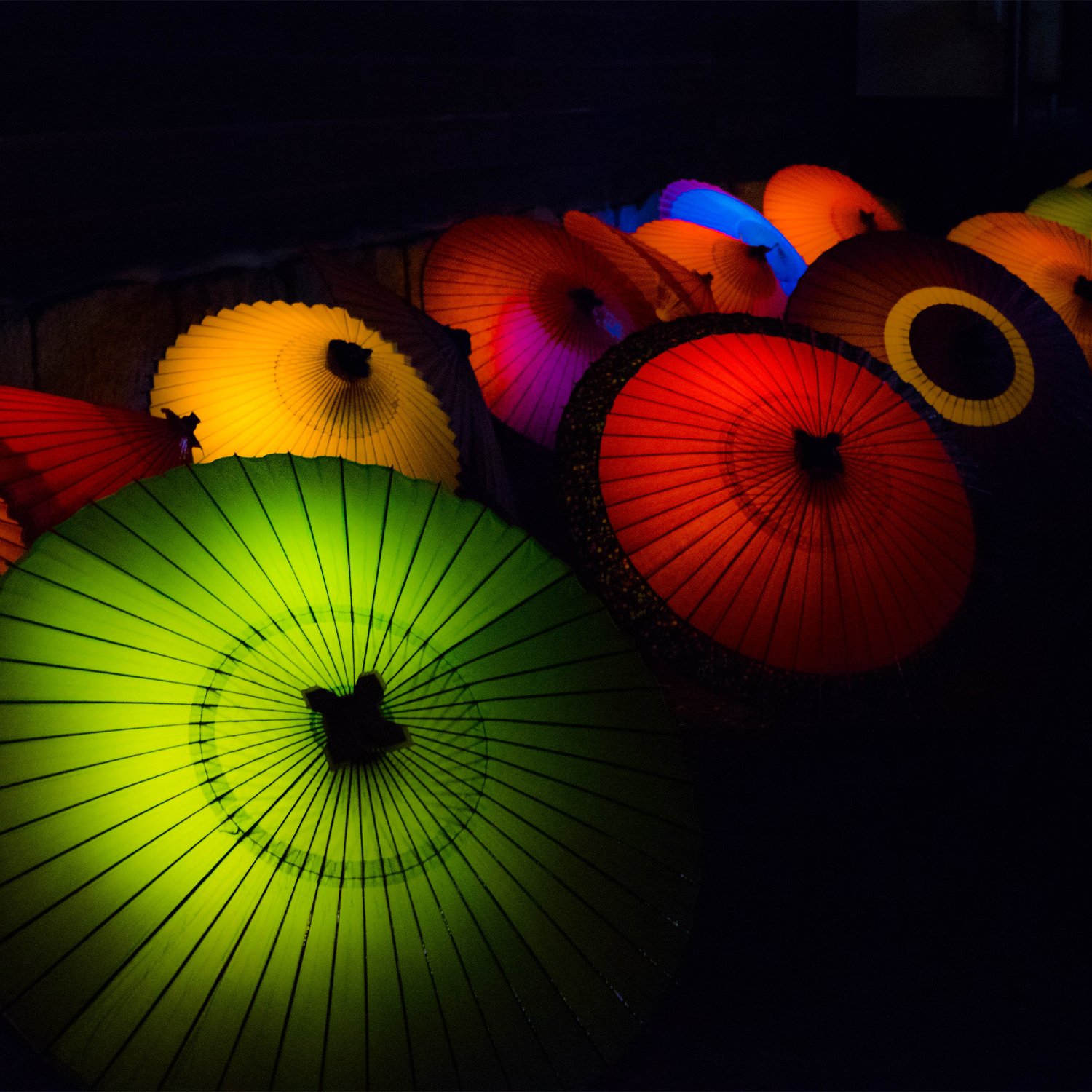
Illustration by Hiroyuki Izutsu for Agent Hamyak
Please remember that the value of an investment can fall and you may not get back the amount invested. This article originally featured in Baillie Gifford’s Autumn 2023 issue of Trust magazine.
Whatever happened to Japan’s industrial and exporting giants? The Sumitomos and the Sharps, the Hondas and Hitachis?
The tall trees symbolising the nation’s industrial and exporting might were outgrown by nimbler international rivals. The ingenious technologies they pioneered became easily reproducible, often more cheaply.
Take Sharp, for example. A pioneer in the LED technology behind flat-screen TVs and computer monitors, it lost ground to South Korea’s Samsung and LG. Margins shrank, restructuring failed, and Foxconn of Taiwan took it over in 2016.
But that’s not the end of the story. Japan’s industrial forest floor is teeming with a new generation of innovators. They specialise in the areas that will matter most to key emerging technologies, opening up opportunities for those who can spot them.
So argues Praveen Kumar. He says these small and medium-sized companies (SMEs) – often family-run for generations – combine manufacturing excellence with a knack for seizing chances. It’s a growth story that has somehow flown under the radar, he says.
Small superstars
“As the leaders of yesterday become less dynamic, we’ve seen a lot of SMEs emerge seemingly from nowhere,” says Kumar.
“They’ve established amazingly high market share positions in critical industries. There’s been a shift from making visible consumer-facing products to essential industrial components requiring a high level of precision and sophistication.”
Unlike in Japan’s first two great flowerings of technological prowess – the late-19th century Meiji era of catch-up with the west and the post-war economic miracle – Kumar says the ‘third wave’ companies are unfettered by complex industrial crossholdings.
These small players marry commercial opportunism and vision with Japanese values of loyalty and a jobs-for-life culture.
The latter is often sneered at in the west, but Kumar sees it as an important contributor to Japan’s technological supremacy.
So, who are the secret superstars that Shin Nippon sees as breathing fresh life into Japan’s investment landscape? Kumar picks out three.
Measuring and more
Family-run business Horiba attracted international attention through its part in uncovering the 2015 Volkswagen emissions scandal. It makes automotive emission testing equipment for measuring and analysing exhaust gases and has an 80 per cent global market share.
But few are aware of its equally astonishing 60 per cent global market share in mass-flow spectrometers, which are precision instruments used to measure and control the flow of liquids and gases in the semiconductor manufacturing process.
“It sees itself as a measuring device manufacturer, pure and simple,” says Kumar. “Its research and development is geared in such a way that it can develop devices to measure any number of things.”
He cites Horiba’s recent involvement in the chemical analysis of sand and stone samples from the asteroid Ryugu, collected by the Japanese space agency’s Hayabusa2 spacecraft.

As part of an international team using specialist microscopes to explore Ryugu’s elemental makeup – water, carbon and other organic material dating back billions of years – Horiba’s experts are helping to unravel the mysteries of the birth of the solar system.
Adaptability enables Horiba nimbly to reposition itself in response to the global transition to electric vehicles. Now it’s developing superior instruments to gauge EV battery efficiency.
Kumar says Horiba’s 2015 acquisition of UK-based MIRA, a provider of vehicle testing facilities, underscores its vision. “By owning an industrial park in Nuneaton in Warwickshire where automotive players test technologies, Horiba gains real-time intelligence,” he notes.
That’s the other shift that we’ve seen. More interaction with the end customer leads to the development of the precision tools they need. It’s like supplying picks and shovels in the gold rush.
Indispensable expertise
Torex Semiconductor produces analogue power integrated circuits (ICs). Unlike digital chips, which can only distinguish between binary ‘on’ and ‘off’ signals, analogue chips can handle gradations in between.
They govern the battery charging function in your mobile phone or iPad, or the brightness of your LED lights, ensuring the right amount of power for proper functioning and damage prevention.
The miniaturised devices go to the heart of Japanese monozukuri (literally, ‘thing-making’), often criticised as inefficient in an age of digitisation and commoditised goods.
Kumar says extreme capability allows Torex to dominate a niche that’s indispensable to multiple technologies, from solar grids to smartphones and sensors.
“Torex’s strength is in analogue electronics. In digital, it’s relatively easy to build and develop products. Analogue is trickier. You don’t have many experienced engineers since it requires a high level of hands-on expertise that is often built over decades.”
Kumar argues that employers’ loyalty to their workers – contrasted with the western propensity to jettison staff during downturns – has served companies such as Torex well. It retains talent and institutional know-how at a time when much of Japan struggles with labour shortages.
Precision and perfectionism
Another firm that benefits from Japan’s reputation for precision and perfectionism is JEOL. It began life specialising in transmission electron microscopes for academic and corporate research and development.
But it then spotted an opportunity to transfer this prowess from a low-growth sector to one with more expansion potential. In partnership with Austria’s IMS Nanofabrication, JEOL found a way to disrupt semiconductor manufacturing.
Here’s how. In traditional photolithography – making intricate patterns on minuscule semiconductor wafers – a ‘mask’ made of glass or quartz acts as a stencil.
JEOL’s optical technology has created a device so precise it can send more than 260,000 electron beams, made up of microscopic streams of charged particles, directly on to the wafer. This eliminates the need for those expensive masks.
“This machine has a phenomenal level of accuracy,” says Kumar. “And because it can drastically reduce costs, JEOL has basically got a monopoly.”
Promising prospects
Kumar describes Shin Nippon’s continuous quest for similar cases of unique manufacturing mastery.
Promising prospects on its radar include companies involved in high-end sealing technologies used in the semiconductor manufacturing process and production equipment for the manufacture of silicon carbide, the ‘wonder material’ of chipmaking, whose special properties include a tolerance for high temperatures.
“The ability to expand into completely new areas, not through acquisitions but by their own skills, is a hallmark of these specialist companies,” says Kumar.
He notes that, while these small firms frequently find themselves undervalued by major investment players, it is often the proverbial ‘Mrs Watanabe’ – Japan’s shrewd retail investor – who catches wind of these innovators.
“There’s very little foreign ownership of these niche manufacturers,” says Kumar. “Even Japan’s big institutions, such as pension funds, will never have heard of them. So, the opportunities are truly significant.”
Important information
Investments with exposure to overseas securities can be affected by changing stock market conditions and currency exchange rates.
Baillie Gifford Shin Nippon’s exposure to a single market and currency could increase risk.
Investing in smaller, immature companies is generally considered higher risk as changes in their share prices may be greater and the shares may be harder to sell.
Smaller, immature companies may do less well in periods of unfavourable economic conditions.
The views expressed in this article should not be considered as advice or a recommendation to buy, sell or hold a particular investment. The article contains information and opinion on investments that does not constitute independent investment research, and is therefore not subject to the protections afforded to independent research.
Some of the views expressed are not necessarily those of Baillie Gifford. Investment markets and conditions can change rapidly, therefore the views expressed should not be taken as statements of fact nor should reliance be placed on them when making investment decisions.
Baillie Gifford & Co Limited is wholly owned by Baillie Gifford & Co. Both companies are authorised and regulated by the Financial Conduct Authority and are based at: Calton Square, 1 Greenside Row, Edinburgh EH1 3AN.
The investment trusts managed by Baillie Gifford & Co Limited are listed on the London Stock Exchange and are not authorised or regulated by the Financial Conduct Authority.
A Key Information Document is available by visiting bailliegifford.com
58412 10035561





